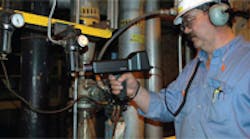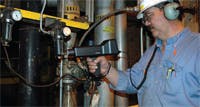Companies requiring an audit usually do their best to conserve energy. Most energy engineers realize the high cost of energy drain from the power wasted by air compressors trying to maintain preset air pressures. Much of this energy drain stems from air leaks, which can not only negatively impact the system as a whole, but also can affect the environment and quite possibly the health of personnel who have to work around them.
Negative impacts on control
Air leaks can impact processes negatively. Control and pressure reducing valves are relied upon to control the manufacturing process. Precise control is critical to the products produced and to indoor environments.
Compressed air systems in a plan may control more than just the air cylinders, motors, and other actuators on automated equipment. For example, in biotech facilities, compressed air may control ventilation systems, where maintenance of humidity and temperatures are an utmost priority. If the degree of humidity in a controlled biogenetic research facility goes awry, it can ruin months or years of research. Loose connections or splits in tubing can adversely impact proper control. Obviously, a ruptured diaphragm in a control valve cannot be properly controlled by a computer. Therefore, it should be apparent that facilities need to perform compressed air leak audits on a regular basis, or make arrangements with a competent firm to have audits conducted periodically.
Many critical components in a compressed air system require validation to ensure they are operating to original specifications. Likewise, noncritical system components need to be assessed for leakage. They include, but are not limited to pressure- and directional-control valves, fittings, hoses, thread connections, FRLs, and quick-acting couplings. If they are leaking, they not only waste energy, but may reduce system productivity and product quality.
Unseen sources
One of the challenges to finding air system leaks is that many sections of system piping may be inaccessible. Just because a leak can’t be seen or heard doesn’t mean it doesn’t exist.
Most compressed air systems require not only clean, but dry air. Wherever moisture is separated out of the compressed air stream, some form of drain must be provided to remove the water. A manual drain may be used in small systems, but plant air systems generally incorporate automatic drain traps. Drains should be located in the lowest portions of system piping, which makes them difficult to reach. Just because they are hard to get at does not diminish their potential for leakage.
When a drain trap sticks in the closed position it causes the condensed water to accumulate within the system. Thus, the air will contain water that can impede proper operation and cause long-term effects, such as rust, dirt, and corrosion. This makes it important to repair or replace drain traps that are stuck closed.
If a drain valve fails in the open position, energy is wasted by allowing the compressed air to escape to atmosphere without having done any work. Because most drain traps are piped into discharge manifolds and then to waste drains, it is not generally visually apparent that they might have failed in the open position. Therefore, it is essential that regular ultrasonic tests be performed on drain traps.
Valves, solenoids, and other components can plug or stick in the open position. Also, the gaskets between banks of valves begin to leak when water has not been drained from the compressed air system. Oil carryover from compressors can degrade O-rings and gaskets, causing them to leak. If portions of the air system piping
are routed outdoors, and temperatures can drop below freezing, the air lines and the equipment to which it leads can freeze. Once frozen, the portions that freeze can crack and be permanently damaged.
The air system is like a food chain, in that a shortcoming in one component in the system can affect others.
Like a wallet with a hole in it
Leaks translate into cash. Allowing leaks to exist without a leak identification and repair program will add a hidden cost to the products your company produces which can negatively impact the ability of the company to compete and affect profitability. These leaks can be compared to having small pinholes in your automobile gas tank. After a while, you’ll notice how they’ve created a hole in your wallet. The sooner leaks are eliminated, the more money you’ll save.
Can a compressed air audit be costeffective for small plants? The answer is yes. Leak detection is important in any size plant, but in smaller plants, financial survival and competitiveness are that much more important. For larger plants, the impact may be exponentially more costly.
When performing an audit in a large plant, it is not unusual to find $5000 or more per day of loss through leakage. Once you get a handle on your leaks, you may be capable of shutting down the operation of an extra compressor.
How often should a leak audit be performed? Audits are typically done semi-annually or at least once a year.
Everyone can pitch in
When leaks become large enough, they become audible without the need for ultrasonic scanning. Heighten the awareness of all individuals in each department. Ask them to report leaks that may be audible. If you do not already own ultrasonic leak detection, consider purchase of equipment and train one or more individuals in each department to perform their own leak audit. These leak auditors should be recognized as “energy conservation champions.” As energy continues to become more expensive, we must take steps to conserve. Our very manufacturing existence might depend on it.
Performing a leak survey
The success of a leak survey requires three major elements:
- knowledge
- planning, and
- follow-through.
Knowledge requires an understanding of the compressed air system on a wide scale, including all the subsystems and components. What are the sizes, types, and ages of the compressors? Have they been properly maintained? What about traps and drains? Are pressure gauges working, and if so, do they indicate adequate pressure for the various areas of use? What are the assigned pressures for these areas? Can some compressed air applications be replaced by other methods? For example, instead of using compressed air for cooling, drying, or cleanup, lowpressure blowers or fans may suffice.
Knowledge can also include the understanding of your ultrasound instrument, how it works, and the techniques of inspection. If you are not sure about the technology or how to use the instrument, training courses can help make you and other inspectors in your facility more competent and effective in your inspections.
Planning incorporates elements such as a map of the compressed gas system and its various components. If none exists, shoot digital photographs of each section using wide-angle and close-up views and labeling them. Planning also includes scheduling of the survey. Break up the survey so that it can be performed without negatively affecting other maintenance responsibilities of the personnel assigned to be the leak team.
Before the survey begins, have inspectors walk through the various sections to review their route. In planning the walk-through, be sure to discuss safety procedures and equipment and additional equipment that may prove useful, such as flashlights, keys, or specialized leak inspection attachments.
In addition to finding leaks, the walk-through also can identify:
- potential safety issues,
- changes needed to the routing of piping, and
- placement of components. Key components, such as dryers, drains, and
compressors may have initially been installed at a location that was convenient at the time. But plant expansion and reconfiguring may have occurred. Relocating major components could make them more accessible for maintenance or make the system operate more efficiently.
ID for action
Another component to planning includes a leak identification method. Once a leak has been located, it should be tagged. A tag number can be used, along with a photograph of the leak in the report. The identification process is extremely important. The leak rate can be assigned to the leak in a report that can than be used to demonstrate the cost savings and potential environmental impact of the leak. In addition, the leak identification process can be used to be sure a leak is repaired. It is very costly not to repair an identified leak.
Follow-through is another important factor. If a leak is not repaired, all the effort and cost of the survey will be wasted. Therefore, use a follow-up method to ensure that all identified leaks have been repaired. In addition, when a leak has been reported as fixed, the repair should be checked. Sometimes the repair might cause another leak to occur or the wrong component may have been “repaired.” Followthrough includes review of the survey, cost analysis, and, when possible, environmental impact analysis. A report can then be generated to demonstrate the effectiveness of the survey and the related cost savings benefits.
Follow-through should also include leak management. Even though a survey has been completed, many leaks may still exist. The problem is that the shear volume of these leaks can seem overwhelming to a maintenance department that is already working hard at meeting the daily maintenance requirements they are normally assigned.
Establishing a system that will allow for the leaks to be repaired is important. One method is to prioritize the leak repair so that the most costly leaks are repaired first. Progressively smaller leaks are then repaired over time. Once the last of these has been repaired — which may be several months after the audit — it might be wise to plan another audit. This helps hold leakage at bay and also helps you gain a greater return on your investment of equipment used in the audit.
Record keeping is another important element to the follow through part of a survey. Some companies provide software that can help, such as freeware offered by UE Systems Inc. It combines data management and comprehensive compressed gas survey analysis. Users can review annualized and monthly data that include leak cost and greenhouse gas savings.
Conclusion
Compressed air can be costly in more than the obvious. The cost of producing or purchasing the gas is one factor. Safety, the environment, and equipment degradation caused by leaks and equipment inefficiencies can all add up in many ways that can impact a company’s ability to compete and maintain profitability. A planned, comprehensive leak survey program can provide savings that can improve plant-wide productivity and profitability.
Bruce Gorelick, vice president, Enercheck Systems, Charlotte, N.C., wrote this article, and Alan Bandes, vice president, UE Systems, Elmsford, N.Y., assisted with statistics. For more information, visit www.enerchecksystems.com and www.uesystems.com.



